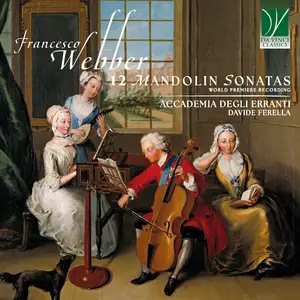
Francesco Webber (fl 1724-1751)
Mandolin Sonatas
Accademia degli Erranti/Davide Ferella (mandolin)
rec. 2023, Palazzo Cigola Martinoni, Cigole (BS), Italy
Reviewed as download from Da Vinci Classics
Da Vinci Classics C00985 [83]
It is remarkable that in recent years the mandolin has received quite some attention through recordings. Previously, only the concertos by Vivaldi were performed and recorded, and that was well before the revival of early music and the emergence of historical performance practice. One could easily get the impression that those were about everything in the realm of ‘serious’ music written for the instrument. Otherwise, it was mostly played by amateurs and folk music groups. Mandolin orchestras played music that was arranged for them. The recordings released in the last ten years or so have entirely changed the status of the mandolin, although we are probably still far from seeing the instrument appear in public concerts.
The instrument first appears in the late 16th century. It was called mandola; about half a century later, its diminutive name mandolino turns up. These two terms were used simultaneously until well into the 18th century. The first collection of music specifically intended for the mandolin dates from the third quarter of the 17th century in Florence. The first printed music of a few balletti for a 5-course mandolin is included in a method for guitar by Giovanni Pietro Ricci (Rome, 1677), suggesting that the first players of the mandolin were guitarists.
In the 17th century, the mandolin was played exclusively in Italy, and in the public perception it may still be considered an Italian instrument. After 1700, it started to be disseminated across Europe. In the 18th century, it enjoyed some popularity in Paris, as has been documented by the ensemble Pizzicar Galante (review). The present disc brings us to England, where the mandolin was played for the first time in 1707 by Francesco Bartolomeo Conti, who from 1701 to 1726 was in the service of the imperial court in Vienna as theorbist. He was also an excellent mandolin player, and when he appeared in London, an advertisement mentioned that he was to play on “an instrument not yet known”. The ensemble Artemandoline recorded a programme with music for the mandolin written in England in the course of the 18th century (deutsche harmonia mundi, 2024). One of the composers figuring in their programme is Francesco Webber (or Weber), who arrived in London in 1724 and performed a mandolin concerto in 1728.
Webber did not come to England to play the mandolin. He was a theorbist, like Conti, and played in this capacity in Handel’s opera orchestra. He taught the mandolin to Princess Amelia of Wales, which is an indication of the growing popularity of the instrument in England. The sonatas which are the subject of this disc are the direct fruit of this tuition, as Webber composed these sonatas for the Princess. Today, they are preserved in the British Library in London.
The collection consists of twelve sonatas; ten of them are in three movements, two in four. The order of the movements is various: some sonatas open with a movement in a slow or moderate tempo, followed by a fast movement. The last movement is always a dance: giga, gavotta or menuet. Eight sonatas end with a menuet, which indicates that these pieces are written in the galant idiom. However, they are far from easy, let alone superficial. The slow movements are certainly not devoid of expression, and the fast movements are often virtuosic. This is no amateur’s stuff.
For those who want to get some idea on a platform which offers the opportunity to listen, here are a few highlights: the sostenuto from Sonata II, the opening movement of Sonata VI (no time indication, but here played as an allegro) and the entire Sonata VIII. These are just a few examples, but this disc can be enjoyed from start to finish; there is no dull moment here, due to the quality of Webber’s sonatas but certainly also of the performers. Davide Ferella is a brilliant player, who delivers sparkling performances of the fast movements and fully explores the expressive moments. He receives excellent support from Thomas Chigioni (cello), Laura La Vecchia (guitar) and Gabriele Levi (harpsichord), who show a perfect feel for the rhythmic pulse in these sonatas.
If you are not familiar with the mandolin and are wondering whether it is a serious instrument, this disc is the perfect way to get to know it and overcome any scepticism.
Johan van Veen
www.musica-dei-donum.org
twitter.com/johanvanveen
Buying this recording via a link below generates revenue for MWI, which helps the site remain free

Contents
Sonata I
Sonata II
Sonata III
Sonata IV
Sonata V
Sonata VI
Sonata VII
Sonata VIII
Sonata IX
Sonata X
Sonata XI
Sonata XII
N.B. No keys mentioned

















